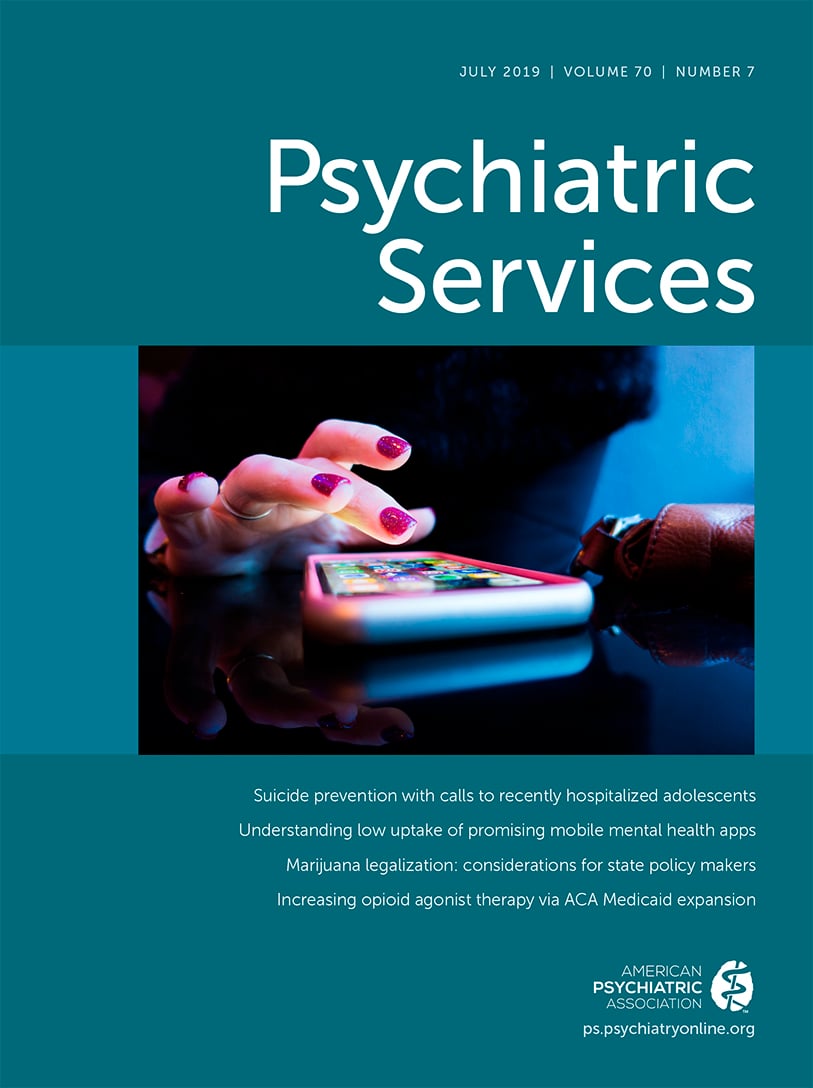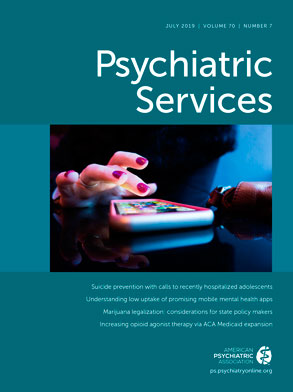Research has indicated that primary care providers (PCPs) tend to screen patients with visible symptoms, generating a national screening rate of 4.2% for depression (
1). These individual-level approaches leave black patients half as likely to be screened as white patients. In addition, elderly patients are half as likely as middle-aged patients to be screened, and female patients are more likely to be screened than male patients. Of those diagnosed as having a major depressive episode in 2016, 63% of adults received medication, therapy, or medication and therapy as treatment, and 37% did not receive any treatment. Among adolescents diagnosed as having a major depressive disorder in 2016, 40% received medication, therapy, or medication and therapy as treatment, and 60% received no treatment (
2).
In 2015, the U.S. Preventive Services Task Force recommended universal depression screening for adults in primary care settings and appropriate treatment, citing evidence that screening itself provides a net benefit (
3). Population-based approaches, such as collaborative care models (
4,
5), offer unique opportunities to reduce biases of individual-level screening by leveraging algorithms and, in this adaptation, the electronic health record (EHR) infrastructure, prompting providers to screen all eligible patients. In addition, collaborative care model interventions optimize limited mental health resources and expand the reach of mental health care into primary care (
6–
8).
A large academic medical center in Chicago is in the second year of implementing a collaborative care team. The intervention begins with an algorithm in the EHR that determines eligibility for a Patient Health Questionnaire–2 (PHQ-2) screening: on the visit date, the patient is eligible if age 12 or older and if screening has not been received in the previous 12 months. For eligible patients, the EHR prompts the medical assistant to administer the PHQ-2. For PHQ-2 scores ≥3, the Patient Health Questionnaire–9 (PHQ-9) is integrated, with a best practice advisory, into the PCP workflow to complete positive screenings. If the patient’s score is ≥10, the EHR prompts the PCP with a referral order.
If the patient and PCP decide to initiate a referral, a care manager phones the patient within seven days to discuss symptoms and treatment options beyond medication, which the PCP may discuss with patient during the appointment. The PCP may consult with the collaborative care team psychiatrist for assistance with prescriptions. The care manager may provide brief cognitive-behavioral therapy or a community referral as well as case management while the patient is engaged in treatment. The PCP asks the patient to return for a follow-up visit in 6 to 8 weeks.
Using routine EHR data, we analyzed depression screening, referrals, and treatment uptake during the first 14 months of implementation across 10 clinics. In this analysis, we aimed to identify any screening and treatment disparities along the axes of gender, race, ethnicity, and age cohorts.
Methods
EHR data were pulled from the primary care clinics where PHQ-2 and PHQ-9 screenings took place during routine office visits between November 2016 and December 2017 with varying starting points of implementation. Total eligible patients per clinic were counted from the time the intervention launched at that clinic through December 31, 2017. Only three clinics began the collaborative care team intervention in November 2016, whereas the remaining seven clinics began implementation in the months between March 2017 and November 2017. The ninth and 10th clinics to implement the intervention (in November 2017) did not begin screening during the 14-month window, although they did refer patients to collaborative care and are included in the referral and treatment data. The final sample consisted of 25,369 unique, eligible patients. In addition, we pulled PHQ-2 screening data for the same clinics in the previous year for comparison.
To conduct the analysis, we extracted data from the EHR data warehouse regarding demographic characteristics, PHQ screenings, psychotropic prescriptions, and care manager psychotherapy orders. Demographic measures included age, gender, race, and ethnicity. We used the eligibility algorithm to determine how many patients were seen over the course of 14 months and what proportion was screened for the PHQ-2 and PHQ-9. We examined descriptive demographic statistics of eligible patients and compared them with those who were screened. We calculated Cohen’s h coefficient (h≥0.20), a two-tailed test of two proportions that is less sensitive to sample size than a z-score test of proportions. This test identified any meaningful differences in proportions between those eligible and those screened for the PHQ-2 and the PHQ-9 and between those referred to treatment and those who engaged in treatment.
We tested the distributions of each subgroup with chi-square tests. To examine referral data, we filtered prescription orders by antidepressants plus other psychotropic medications used adjunctively to treat depressive symptoms. Finally, we counted the number of unique patients with orders for cognitive-behavioral therapy and verified how many received therapy in the team’s flowsheet data. R, version 3.5.1, was used to conduct statistical analyses (
9). The institutional review board approved the study as quality improvement.
Results
Female patients (63%, N=15,966) dominated the sample of unique, eligible patients seen in primary care during the study period (see online supplement). In terms of race, white (44%, N=11,238) and black (36%, N=9,017) patients had the largest shares of the sample, followed by patients of “other” race-ethnicity (14%, N=3,663). Asians, Native Americans, and Pacific Islanders made up less than 5% (N=1,121) of the sample. In terms of ethnicity, 19% (N=4,893) identified as Hispanic-Latinx, whereas 80% (N=20,268) did not, and 1% (N=208) refused to answer. Approximately 20% (N=4,912) of the sample were between ages 12 and 25, and 19% (N=4,856) were between ages 26 and 35.
Analysis of screening data revealed that 79% (N=20,053) of eligible patients (N=25,369) were screened with the PHQ-2. On the basis of Cohen’s h, no meaningful effect sizes were found across all demographic categories between proportions of eligible patients and screened patients (see online supplement). During the 12 months before the launch of the intervention, 7.2% (N=2,340) of the 32,495 eligible patients were screened with the PHQ-2.
The clinics screened 66% (N=1,042) of eligible patients (N=1,588) with the PHQ-9 during the study period. Screenings reflected no meaningful differences in proportions of screened and eligible patients across categories of gender, race, ethnicity, and age, with the exception of a small effect size for 12- to 17-year-olds (see online supplement). Specifically, among patients eligible for the PHQ-9 screening, 12% (N=196) were adolescents; among patients screened, 20% (N=203) were adolescents (Cohen’s h=0.20, p<0.05).
Seventy-six percent (N=796) of patients screened with the PHQ-9 scored a 10 or higher, or 3% of the original sample of eligible patients. A total of 638 patients were referred to collaborative care (
Table 1), and case worker flowsheet data revealed that a portion of the referred patients (8%, N=53) then reported that they were already in treatment, including seven adolescent patients. Most referred patients (69%, N=438) fell within the moderate risk category, whereas 15% (N=93) fell in the severe risk category (see
online supplement).
Seventy-three patients were referred without a PHQ-9 score; 17 of those were from the two clinics that had not begun screening with the collaborative care team flowsheet, and 27 were adolescent patients, whereas the remaining 29 patients were adults from the other seven clinics. When testing proportions referred to treatment (N=638) compared with proportions engaged in treatment (N=370), one distinct trend emerged (
Table 1). Although adolescents were disproportionately screened for the PHQ-9, they were not engaging in treatment (11%, N=42) compared with referred (22%, N=137) proportions of the sample (Cohen’s h=0.28). Although not significant in terms of effect size, results show that white patients were trending toward disproportionate engagement in care.
Three hundred seventy (58%) patients with referrals to the collaborative care team engaged in some form of treatment. Treatment pathways (see online supplement), although not entirely mutually exclusive, showed that most treatment-engaged patients (78%, N=289) chose medication to treat their depression, whereas 9% (N=33) chose brief cognitive-behavioral therapy, and 4% (N=15) engaged in brief therapy and medication combined. Twenty percent (N=125 of 638) were referred to community mental health providers who were likely more accessible CCT therapists, and some of these patients also may have opted for medication.
Discussion and Conclusions
This study highlighted the effectiveness of PHQ-2 and PHQ-9 screening integration into the EHR primary care workflow as an initial step of a collaborative care model. PHQ-2 screenings rose from 7% to nearly 80% of eligible patients during the first 14 months of implementation. An effective EHR infrastructure and an interdisciplinary care team to which patients with depression may be referred facilitated routine, universal screening. Population-level screening is one way to integrate mental health into primary care. This strategy normalizes mental health, thus addressing associated stigma; provides an entry into mental health care that many patients may not otherwise have; and when depressed patients opt for antidepressant medication, visits to primary care increase for medication management (
5,
10–
12).
Barriers to care persist. Only 3% (N=796) of eligible patients screened positive, less than the national prevalence of 6%–8% (
2). Patients may decline to answer the PHQ-2 or deny symptoms because of trust, privacy, and stigma issues, and providers may hesitate to screen because of their own discomfort or because of a lack of time and competing priorities.
Although engagement in treatment appeared to be low, at 58% of 638 referrals, it is comparable with national rates. It may even be viewed as an improvement because the high screening rates have identified more symptomatic patients than have been found with individual-level screening methods (
1). PCPs may need a mechanism to document systematically people with positive screens who decline referrals because they already see mental health providers. Greater levels of treatment engagement may prevent or improve comorbid conditions (
13). Overall, patients used psychotropic medications more than any other form of treatment; however, adolescents and persons of color may engage in treatment at higher rates if brief therapy is offered at expanded hours or in more accessible spaces (
14).
Study limitations included selection bias whereby healthier patients may have been more likely to use primary care; similarly, providers may have had less time during appointments to screen patients who were unhealthy, for whom depression may have been comorbid with general medical illness. The prevalence of patients eligible for the PHQ-9 (6%, N=1,588) and subsequently for a referral (3%, N=796) may be low because of that selection bias. In addition, the data extracted may be incomplete if collaborative care team providers did not register screening, referral, treatment, or outcome data. Implementation literature has documented PCPs’ tendency not to record negative scores (
12). In this study, follow-up PHQ-9 scores were inconsistent and were not standardized in the collaborative care team provider workflows.
More research is needed in several areas, such as increasing PHQ-9 screening rates, conducting and documenting follow-up scores, and, most importantly, gathering patient perspectives on ways to improve treatment uptake, particularly with pediatric patients and patients of color. Warm handoffs, innovative treatment modalities, and more accessible therapies may be needed to better engage patients in treatment.

